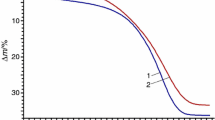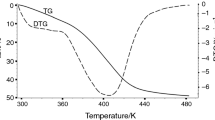Abstract
Inclusion compounds based on metal–organic frameworks (MOFs) have promising practical applications in gas storage, the separation, and fine purification of substances, and also in catalysis. These MOFs are crystalline compounds consisting of metal ions coordinated by bridging organic ligands with the formation of porous structures. We study the kinetic stability of two inclusion compounds on the base of the new framework: [Zn4(dmf)(ur)2(ndc)4]·6C6H6 and [Zn4(dmf)(ur)2(ndc)4]·5C6H5CH3 (ndc2− = 2,6-naphtalenedicarboxylate, ur = hexamethylentetramin, dmf = N,N′-dimethylformamide). The inclusion compound with benzene is more stable than the compound with toluene. The reduced stability of the toluene compound may be connected with the toluene molecule’s shape: the C6H5CH3 molecule is more bulky and asymmetric than the C6H6 molecule; the MOF matrix structure must be greatly distorted to include the toluene molecules and the compound stability decreases.









Similar content being viewed by others
References
Fromm KM. Coordination polymer networks with s-block metal ions. Coord Chem Rev. 2008;252:856–85.
Kirillov AM. Hexamethylenetetramine: an old new building block for design of coordination polymers. Coord Chem Rev. 2011;255:1603–22.
Mani-Biswas M, Tahir Cagin T. Insights from theoretical calculations on structure, dynamics, phase behavior and hydrogen sorption in nanoporous metal organic frameworks. Comput Theor Chem. 2012;987:42–56.
Lyszczek R, Iwan M. Investigation of desolvation process in lanthanide dinicotinates. J Therm Anal Calorim. 2011;103:633–9.
Jiang C-H, Song L-F, Jiao C-L, Zhang J, Sun L-X, Xu F, Du Y, Cao Z. Exceptional thermal stability and thermodynamic properties of lithium based metal–organic framework. J Therm Anal Calorim. 2011;103:373–80.
Zhou Y-X, Sun L-X, Cao Z, Zhang J, Xu F, Song L-F, Zhao Z-M, Zou Y-J. Heat capacities and thermodynamic properties of M(HBTC)(4,4′-bipy)·3DMF (M = Ni and Co). J Therm Anal Calorim. 2012;110:949–54.
Dybtsev DN, Yutkin MP, Peresypkina EV, Virovets AV, Serre C, Ferey G, Fedin VP. Isoreticular homochiral porous metal–organic structures with tunable pore sizes. Inorg Chem. 2007;46:6843–5.
Dybtsev DN, Yutkin MP, Samsonenko DG, Fedin VP, Nuzhdin AL, Bezrukov AA, Bryliakov KP, Talsi EP, Belosludov RV, Mizuseki H, Kawazoe Y, Subbotin OS, Belosludov VR. Modular homochiral porous coordination polymers: rational design, enantioselective guest exchange sorption and ab initio calculations of host–guest interactions. Chem Eur J. 2010;10:348–56.
Jiang X, Jiao C-L, Sun Y-J, Li Z-B, Liu S, Zhang J, Wang Z-Q, Sun L-X, Xu F, Zhou H, Sawada Y. Heat capacities and thermodynamic of Co(3,5-PDC)(H2O). J Therm Anal Calorim. 2013;112:1579–85.
Deb N. An investigation on solid-state pyrolytic decomposition of barium trihemiaquatris(oxalato)lanthanate(III)decahydrate using TG–DTA in air and DSC in nitrogen. J Therm Anal Calorim. 2013;112:1415–21.
Yang Q, Xie G, Chen S, Gao S. Synthesis, structure and thermodynamics of supermolecular compound [Ni3(Hdatrz)6(sca)2(H2O)4]sca·11H2O (Hdatrz = 3, 5-diamino-1, 2, 4-triazole, H2sca = succinic acid). J Therm Anal Calorim. 2012;110:979–84.
Logvinenko VA, Yutkin MP, Zavakhina MS, Fedin VP. Porous metal–organic frameworks (MOFs) as matrices for inclusion compounds: kinetic stability under heating. J Therm Anal Calorim. 2012;109:555–60.
Sapchenko SA, Samsonenko DG, Dybtsev DN, Melgunov MS, Fedin VP. Microporous sensor: gas sorption, guest exchange and guest-dependant luminescence of metal–organic framework. Dalton Trans. 2011;40:2196–203.
Netzsch Thermokinetics. http://netzsch-thermokinetics.software.informer.com/.
Moukhina E. Determination of kinetic mechanisms for reactions measured with thermoanalytical instruments. J Therm Anal Calorim. 2012;109:1203–14.
Kissinger HE. Reaction kinetics in differential thermal analysis. Anal Chem. 1957;29:1702–6.
Friedman HL. Kinetics of thermal degradation of char-forming plastics from thermogravimetry. J Polym Sci. 1963;6:183–95.
Ozawa T. A new method of analyzing thermogravimetric data. Bull Chem Soc Jpn. 1965;38:1881–6.
Ozawa T. Estimation of activation energy by isoconversion methods. Thermochim Acta. 1992;203:159–65.
Flynn JH, Wall LA. General treatment of the thermogravimetry of polymers. J Res Natl Bur Stand. 1966;70:478–523.
Opfermann J, Kaisersberger E. An advantageous variant of the Ozawa–Flynn–Wall analysis. Thermochim Acta. 1992;203:167–75.
Opfermann JR, Kaisersberger E, Flammersheim HJ. Model-free analysis of thermo-analytical data—advantages and limitations. Thermochim Acta. 2002;391:119–27.
Vyazovkin S. Model-free kinetics: staying free of multiplying entities without necessity. J Therm Anal Calorim. 2006;83:45–51.
Simon P. Single-step kinetics approximation employing non-Arrhenius temperature functions. J Therm Anal Calorim. 2005;79:703–8.
Simon P. The single-step approximation: attributes, strong and weak sides. J Therm Anal Calorim. 2007;88:709–15.
Vyazovkin S, Burnham AK, Criado JM, Luis A, Perez-Maqueda LA, Popescu C, Sbirrazzuoli N. ICTAC Kinetics Committee recommendations for performing kinetic computations on thermal analysis data. Thermochim Acta. 2011;520:1–19.
Logvinenko V. Stability and reactivity of coordination and inclusion compounds in the reversible processes of thermal dissociation. Thermochim Acta. 1999;340:293–9.
Logvinenko V. Solid state coordination chemistry. The quantitative thermoanalytical study of thermal dissociation reactions. J Therm Anal Calorim. 2000;60:9–15.
Logvinenko V. Stability of supramolecular compounds under heating. Thermodynamic and kinetic aspects. J Therm Anal Calorim. 2010;101:577–83.
Logvinenko V, Fedorov V, Mironov Yu, Drebushchak V. Kinetic and thermodynamic stability of cluster compounds under heating. J Therm Anal. 2007;88:687–92.
Logvinenko V, Drebushchak V, Pinakov D, Chekhova G. Thermodynamic and kinetic stability of inclusion compounds under heating. J Therm Anal. 2007;90:23–30.
Pinakov DV, Logvinenko VA, Chekhova GN, Shubin YuV. The relationship between properties of fluorinated graphite intercalates and matrix composition. Part VI. J Therm Anal Calorim. 2014;115:503–9.
Logvinenko VA, Belyaev AV, Vorob’eva SN. Dehydration process of rhodium sulfate crystalline hydrate. J Therm Anal Calorim. 2013;114:1177–81.
Hauptmann S, Graefe J, Remane H. Lehrbuch der organischen Chemie. Leipzig:VEB Deutscher Verlag fur Grundstoffindustrie. 1976.
Acknowledgements
This study was partially supported by the Russian Foundation for Basic Research (Grant 11-03-00112-a).
Author information
Authors and Affiliations
Corresponding author
Rights and permissions
About this article
Cite this article
Logvinenko, V.A., Sapchenko, S.A. & Fedin, V.P. Thermal decomposition of inclusion compounds on the base of the metal–organic framework [Zn4(dmf)(ur)2(ndc)4]. J Therm Anal Calorim 117, 747–753 (2014). https://doi.org/10.1007/s10973-014-3827-y
Received:
Accepted:
Published:
Issue Date:
DOI: https://doi.org/10.1007/s10973-014-3827-y




